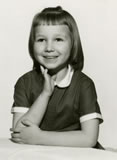 Annie in Primary School (Grades K-3): 1964-1967
Annie in Primary School (Grades K-3): 1964-1967
Annie's what people used to call a "tom boy". She loves being outdoors. Born while her father is in the Air Force, Annette spends her early years living in Iowa, California, Mississippi, Arizona, Utah, Kentucky, and New York all by third grade. Whether playing on a beach in California or Mississippi, the red rocks of the Southwest, the woods of New York, or her grandparent's farm in Iowa, she spends more time barefoot than wearing shoes.
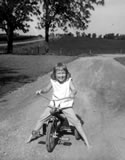
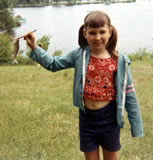
Her parents always made Annette aware of the world around her through vacations and trips to the library to explore the world of reading. She recorded the places she'd lived on a wall map in her bedroom.
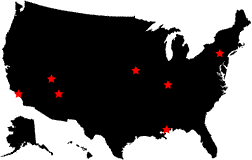
Questioning and Exploration
Annie first hears the word "pollution" in primary school while living in New York in the mid 1960s. Air and water pollution are becoming an increasing concern in this industrial state. Annie lives across the street from a huge electrical sub-station and hears the hum of electricity whenever she leaves the house. Down the road is a salvage yard filled with old crates, boxes, and junk that is surrounded by a dirty creek and small woods. Since her only sibling is much younger, Annie spends most of her time exploring the neighborhood on her own. She's an explorer and spy inventing stories and adventures.
Annie is excited to see a film projector in the classroom. The teacher shows a public service announcement film from the Keep America Beautiful campaign featuring Suzie Spotless chastising her father for littering.
Click the still image from the PSA (above) to learn more about this campaign and view the video.
Annie's teacher writes the word "pollution" on the chalkboard. She says that it's a big word, but an important idea. Then, asks the class to write all the words they can think of to describe pollution. Annie writes:
- dirty
- trash
- littering
- smelly
- bad
Annie has many questions about pollution. She wonders if there is pollution in her neighborhood. Her teacher asks her to write down her questions.
- What is pollution?
- Is pollution like litter?
- Is there pollution in our neighborhood?
- Why do people make things dirty?
- Why don't people clean things up?
Before recess, Annie looks up the word "pollution" in the classroom dictionary. It says "the act or process of polluting, especially the contamination of soil, water, or the atmosphere by the discharge of harmful substances." She then looks up "polluting," "contamination," "harmful," and "substances." Annie adds these words to her word list, but she is a little overwhelmed and confused. She thought pollution was just littering, like when people throw trash out the car window.
After school, Annie runs home and looks up all the words on her list in the World Book Encyclopedia. She determines that some words are more effective than others. For example, dirty, bad, and smelly provided poor results. She concludes that "trash," "litter," and "pollution" are the best, so she puts stars next to these words. She discovers that there are different kinds of pollution such as air pollution and water pollution. She adds questions about air and water pollution to her list.
The next day, Annie goes to the school library and asks the librarian if there are any books on pollution. The librarian shows Annie how to use the card catalog. Using the starred items from her list, she looks up "trash," "litter," and "pollution." There are only a few books and they all look difficult to read. The school librarian provides Annie with some reading strategies for helping to choose books at her reading level. Annie spends most of her time looking at photographs. The librarian directs her to the captions found with the photographs. The pictures show dirty water and smoky sky.
The librarian (instructional specialist) suggests that Annie could use the Reader's Guide to Periodicals to locate magazine articles on pollution. Annie quickly applies the words that yielded successful results when using the card catalog to the Reader's Guide. She's thrilled to find a recent article in National Geographic. Again, the reading is difficult, but the photographs are worth 1000 words.
Assimilation & Inference
Before reading the encyclopedia and browsing the print resources, Annie thought pollution was just trash or litter you find along the sidewalk or the road. Her reading and thinking has helped her refine her definition of pollution. In the past when she looked out the window, she saw only houses, trees, and sidewalks. Now when she goes outside, she sees pollution everywhere.
 Annie writes in her diary about all the pollution she sees between her home and her friend Pat's house:
Annie writes in her diary about all the pollution she sees between her home and her friend Pat's house:
- There's oil spots on the driveway.
- The sky is not clear, it looks a little brown.
- There are cigarette butts and gum on the sidewalk.
- There's a paper cup and paper sack in the street.
- There's stuff hanging off the water drain in the street. It looks like part of an old shirt.
As an emerging student information scientist, Annie is beginning to see the world differently as a result of her investigation. Next, she begins to apply this knowledge to make decisions.
Annie asks her parents why people pollute. They say that people are often too lazy find a trash can. Annie asks how the water and air gets so dirty. Her parents talk about hazardous chemicals from heavy industry contaminating the air and water. Annie's eyes glaze over, she goes to her bedroom, and looks up the words "hazardous" and "chemical" in the dictionary. The dictionary says a chemical is "a substance with a distinct molecular composition that is produced by or used in a chemical process" and hazardous means "marked by danger; perilous." Annie wonders why people would knowingly put bad things in the air and water.
 Over the next several days, everything Annie encounters seems connected to her of the project. A magazine advertisement (Click the ad on the right to see a larger version) convinces Annie to take action. As part of an art project, she creates a poster highlighting all the pollution in the neighborhood. The caption reads "Stop Our Schenectady (SOS) Pollution. Every litter bit hurts YOU." She uses the poster to talk her friends into cleaning up the trash in the community. As they clean up, the children begin to realize that they are only making a small impact. They are able to clean up the trash, but quickly realize that this won't impact the larger air and water pollution problems. Annie still has a limited understanding of the role of economics, regulations, and politics in environmental issues.
Over the next several days, everything Annie encounters seems connected to her of the project. A magazine advertisement (Click the ad on the right to see a larger version) convinces Annie to take action. As part of an art project, she creates a poster highlighting all the pollution in the neighborhood. The caption reads "Stop Our Schenectady (SOS) Pollution. Every litter bit hurts YOU." She uses the poster to talk her friends into cleaning up the trash in the community. As they clean up, the children begin to realize that they are only making a small impact. They are able to clean up the trash, but quickly realize that this won't impact the larger air and water pollution problems. Annie still has a limited understanding of the role of economics, regulations, and politics in environmental issues.
Reflection
Annie has grown as a student information scientist.
Skills. Annie feels like she is becoming a better user of the dictionary and encyclopedia. She understands the differences between these two reference tools. She can use the card catalog and Reader's Guide to Periodicals to locate relevant books and periodicals. She has also learned the importance of good search terms and how to refine searches based on experience. In addition, she sees value in defining unfamiliar terms and exploring related terms. She understandings how to select age-appropriate books and how to deal with books that are above her reading level. She also sees the value of approaching instructional specialists and others for assistance.
Strategies and Scaffolding. Annie understandings the value of brainstorming words, creating and refining lists of questions, and using a diary to record thoughts. She also sees the importance of a quality communication device such as a poster to help persuade her friends to take action.
Realizations. Annie's new understanding of pollution makes her both happy and sad. She feels good after helping to clean up her neighborhood. However she has also discovered that there are some aspects of the pollution issue that are beyond her control. She had many questions that she was not able to answer. In the future, this realization will help her make connections between the choices she makes and the impact these decisions have on the environment.
Standards
Information Literacy Standards Indicators (Selected from Information Power, AASL, 1998)
- Recognizes the need for information.
- Formulates questions based on information needs.
- Seeks information related to various dimensions of personal well-being.
- Develops creative products in a variety of formats.
Indiana Content Standards
- Raise questions about the natural world (K).
- Draw pictures and write words to describe objects and experiences (K).
- Observe, describe, draw, and sort objects carefully to learn about them (1).
- Investigate and make observations to seek answers to questions about the world (1).
- Define and give examples of rules and laws (1).
- Use tools to investigate, observe, measure, design, and build things (2).
- Recognize and describe ways that some materials can be used over again such as recycled paper, cans, and plastic jugs (2).
- Keep and report records of investigations and observations using tools such as journals, charts, graphs, and computers (3).
- Discuss the results of investigations and consider the explanations of others (3).
- Describe how discarded products contribute to the problem of waste disposal and that recycling can help solve this problem (3).
- Explain the consequences of violating laws (3).
![]() Go to Key Terms and Strategies for information about how Annie might have handled key terms and strategies differently with more experience.
Go to Key Terms and Strategies for information about how Annie might have handled key terms and strategies differently with more experience.
Times Have Changed
It's been forty years since Annie's experience. In many ways a child's experience today would be similar. For example, the importance of identifying and applying good search terms and strategies remains essential regardless of whether the child is using a paper-based card catalog or an electronic version.
If Annie's experiences were to take place today, she would have many more tools available for exploration and creation. On the other hand, all these resources may also have distracted her from the acquisition of important reference skills. For example, many more books are available for children on the topic of pollution and environmental awareness than in the 1960s. In addition, websites contain text, graphics, audio, and video directed specifically at children and young adults. These age-appropriate resources may have eliminated some of Annie's frustrations and misunderstandings. However, they may not have provided the challenge necessary to encourage skill development in areas such as looking up unfamiliar words. In addition, Annie was forced to make her own connections independently rather than reading the answers.
In today's environment, Annie may have used technology tools for producing her poster and a digital camera to record "before" and "after" photographs of her community cleanup.
Related Children's Resources
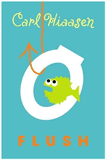 Base, Graeme. The Sign of the Seahorse : A Tale of Greed and High Adventure in Two Acts. - coral reef pollution
Base, Graeme. The Sign of the Seahorse : A Tale of Greed and High Adventure in Two Acts. - coral reef pollution
Base, Graeme. The Water Hole. Harry N Abrams. - water conservation
Caduto, Michael. Keepers of the Earth: Native American Stories and Environmental Activities for Children (Keepers of the Earth). Fulcrum Publishing, 1999.
Cherry, Lynne. The Great Kapok Tree: A Tale of the Amazon Rain Forest. - rainforest
Cherry, Lynne. A River Ran Wild. - ecology
Cherry, Lynne. The Shaman's Apprentice: A Tale of the Amazon Rain Forest. - rainforest
Fleischman, Paul. Seedfolks. - urban garden
Geisel, Theodor Seuss. The Lorax. Random House, 1971. - ecology
George, Jean Craighead. Eco Mystery Series.
Gibbons, Gail. Recycle!, 1996. - recycle
Harlow, Rosie. Garbage and Recycling, 2002.
Hiaasen, Carl. Flush. Knopf Books for Young Readers, 2005. - water pollution
Hiaasen, Carl. Hoot. Knopf Books for Young Readers, 2004. - endangered animals
McDonald, Megan. Judy Moody Saves the World, 2002. - recycling
Showers, Paul. Where Does the Garbage Go? HarperTrophy, 1994. - recycling
Strauss, Rochelle. Tree of Life: The Incredible Biodiversity of Life on Earth, 2004. - biodiversity
Related Websites
Project Learning Tree (http://www.plt.org/)
An award-winning environmental education program designed for teachers and other educators PreK-12.

